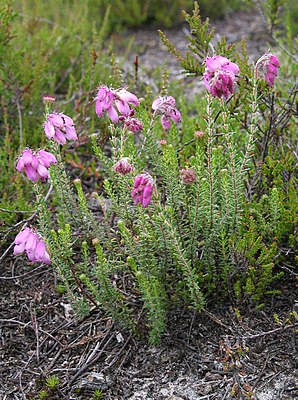Bell heather
| Bell heather | ||||||||||||
|---|---|---|---|---|---|---|---|---|---|---|---|---|

Bell heather ( Erica tetralix ) |
||||||||||||
| Systematics | ||||||||||||
|
||||||||||||
| Scientific name | ||||||||||||
| Erica tetralix | ||||||||||||
| L. |
The bell heather ( Erica tetralix ), also called bog bell heather , belongs to the heather family (Ericaceae). The terms Doppheide ( Stormarn ), Toppheide and Dopphehe ( Ibbenbüren ) refer to the shape of the corolla. "Double" means something like "hollow rounding". Other names are Sumpfheide , Torfheide , Suerheid (Bergisch), Forchheide and Frühlingsheide .
description
The evergreen dwarf shrub ( Chamaephyt ) reaches heights of growth between 15 and 50 centimeters. The needle-shaped leaves are 3 to 6 millimeters long. They stand lively and sparsely sticking out on the stem . They have stiff eyelashes and are rolled up at the edge.
The inflorescence is head-shaped and dold-like and consists of five to fifteen individual flowers . The sepals are four-part and 2 to 3 millimeters long. An outer cup is missing. The corolla of the flowers is 6 to 9 millimeters long, pink and oval in shape. It includes the eight stamens (anthers). The bell heather blooms from June to September.
The number of chromosomes is 2n = 24.
The bell heather is similar to the Irish heather ( Daboecia cantabrica ), but the flowers are significantly larger.
ecology
The bell heather is a dwarf shrub with evergreen coniferous leaves that are rolled up at the edge as an adaptation to the nutrient deficiency of the site; there is therefore a peinomorphosis of the leaves. In addition, the plant forms endotrophic mycorrhiza of the Ericaceae type.
The flowers are "bluebells with scattering device". The stamens are united in a scattering cone. The nectar is the ovary deposited. The corolla is retained after pollination , so that the plant appears blooming for a long time. The flower visitors such as bumblebees and butterflies are of little importance for pollination. Because of their relatively short proboscis, honey bees just can't get to the nectar unless they get it by biting the corolla from the side just like bumblebees . Wind pollination is possible, but relatively rare, while spontaneous self-pollination is widespread. The main pollination, however, is carried out by the only 1 mm large insects from the group of the bladder feet , the so-called "thunderstorm worms", mainly by Taeniothrips ericae , which can be found in the majority of the flowers. The females lay the eggs inside the somewhat fleshy petals, and the larvae develop within the flower. The adult insects also live in the flowers, where they are well supplied by nectar. They are predominantly winged females who fly back and forth after the flowers have opened in order to copulate with the rare and wingless males and thereby cause both the foreign and self-pollination of the flowers.
The fruits are dry capsules hidden in the crown; they are wind spreaders. The seeds are very small and numerous and spread out like granular fliers.
Distribution and location
This heather plant occurs in Atlantic Europe such as Spain , Portugal , northern France , England and Denmark , but also in places in Poland . In Germany, the north-west German lowlands are the focus. Recently, the bell heather has also been anointed in Bavarian moors , where the species did not occur naturally.
Bell heather grows in nutrient-poor moors and moor forests as well as in dwarf shrub heaths and nebulas on acidic, nutrient-poor, sandy-boggy to peaty soils. Typical biotope types are also wet heaths , banks of heather ponds and heather bogs . It also settles in other secondary locations, for example in sand pits and forest clearings. Especially on degenerate, partially drained rain bog locations , it forms so-called bog heaths. In Central Europe it is a character species of Ericetum tetralicis from the Ericion tetralicis association.
Hazard and protection
The Glocken-Heide is mainly endangered by drainage , reforestation or afforestation and by eutrophication of the sites. Larger stocks are often only found in nature reserves. In many places it is displaced by the pipe grass ( Molinia caerulea ) after the sites have been drained . Appropriate biotope care measures such as rewetting and de-bushing can encourage the plant to spread again.
Common names
For the Glocken-Heide exist or existed also the other German-language trivial names : Besenheide, Bohnerheide ( Ostfriesland ), Bultheide ( Unterweser ), Doppheide (Ostfriesland), Fastheide (Unterweser), Moorheide ( Pomerania ), Murheid ( Mecklenburg ), Supfglockenheide, Topfheide ( Hadamar ) and Torfheide.
Sources and further information
Individual evidence
- ↑ Henning Haeupler , Thomas Muer: picture atlas of the fern and flowering plants of Germany (= The fern and flowering plants of Germany. Volume 2). Published by the Federal Agency for Nature Conservation. Ulmer, Stuttgart 2000, ISBN 3-8001-3364-4 .
- ↑ a b Erich Oberdorfer : Plant-sociological excursion flora for Germany and neighboring areas . With the collaboration of Angelika Schwabe and Theo Müller. 8th, heavily revised and expanded edition. Eugen Ulmer, Stuttgart (Hohenheim) 2001, ISBN 3-8001-3131-5 , pp. 734 .
- ^ Georg August Pritzel , Carl Jessen : The German folk names of plants. New contribution to the German linguistic treasure. Philipp Cohen, Hannover 1882, page 143. ( online ).
Web links
- Bell heather. In: FloraWeb.de.
- Bell heather . In: BiolFlor, the database of biological-ecological characteristics of the flora of Germany.
- Erica tetralix L. In: Info Flora , the national data and information center for Swiss flora . Retrieved January 14, 2016.
- Distribution in the northern hemisphere according to Eric Hultén
- Thomas Meyer: Heide data sheet with identification key and photos at Flora-de: Flora von Deutschland (old name of the website: Flowers in Swabia )


